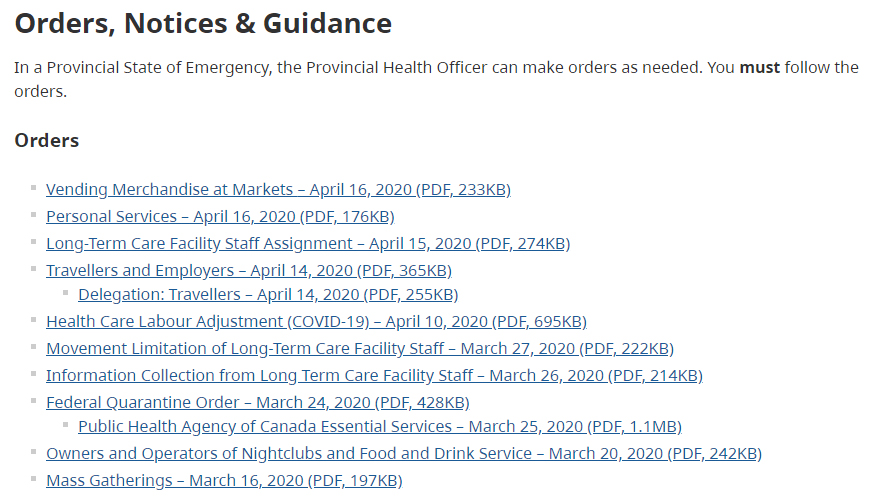
Thursday April 23, 2020 ~ BC [Updated April 24, 2020]
by Mary Brooke, B.Sc. ~ West Shore Voice News
Today Thursday April 23, Provincial Health Officer Dr Bonnie Henry addressed media and British Columbians on Facebook live, with her near-daily briefing on all things COVID-19.
Leading off today — as each day (and as was done by broadcasters back in wartime) with a presentation of current COVID-19 confirmed case statistics, the numbers as of 3 pm today show 29 new cases for a total of 1,824 cases in BC.
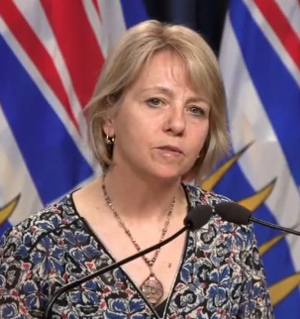
Of the 1,824 cases, the Vancouver Coastal health region has 755, there are 760 in Fraser Health, 111 on Vancouver Island, 156 in the Interior, and 42 in northern BC.
There have been 94 deaths so far in BC (four of those reported new today — all in long-term care facilities).
In BC today, due to COVID-19 there are 103 people in hospital. Of those, 44 are in critical care.
In total in BC to date, 1,092 people who previously tested positive for COVID-19 are declared recovered (based on two consecutive negative tests done at least 24 hours apart).
Outbreaks continue in long-term care homes and assisted living:
As of today April 23 at 3 pm, in total 347 people have been affected by COVID-19 infection in long-term care or assisted living (217 patients and 130 staff).
Today there is one new long-term care facility outbreak – at
Orchard Manor at Hawthorn Park in Interior Health. There are two new outbreaks in acute care at Ridge Meadows and Lions Gate hospitals (both being actively managed as outbreak).

As of today, outbreaks continue in three acute care facilities and in 20 long-term care homes (eight in Vancouver Coastal Health, 10 in Fraser Health, and two in Interior Health), specifically:
- Vancouver Coastal Health: Amica, Edgemont; Berkley Care Centre long-term care facility; Central City Lodge; Haro Park long-term care facility; Lynn Valley long-term care facility; Royal Arch Masonic Home long-term care facility; South Granville Park Lodge long-term care facility; Windermere Care Centre long-term care facility.
- Fraser Health: Cedarbrook Chateau independent living; Chartwell Willow long-term care facility; Dufferin Care Centre; Eden Care Centre long-term care facility; Guildford Seniors Village long-term care facility; Langley Gardens long-term care facility; Langley Lodge long-term care facility; New Vista Care Home long-term care facility; Swedish Canadian Manor assisted living; Worthington Pavilion.
- Interior Health: Kootenay Street Village long-term care facility; Orchard Manor at Hawthorn Park long-term care facility.
The overall list of with affected long-term care homes and assisted living facilities (including where the outbreak is over) totals to 30 in BC. In these 10 locations the outbreaks are declared over: Amica Retirement Home long-term care facility; Delta View long-term care facility; Evergreen Heights assisted living; German Canadian House long-term care facility; Hollyburn long-term care facility; Inglewood Lodge long-term care facility; Little Mountain long-term care facility; Shaughnessy Care Centre long-term care facility; The Harrison at Elim Village long-term care facility; Villa Cathay long-term care facility.
Long-term and assisted living policy has failed seniors:
The numbers of COVID-19 cases are delivered daily in a complex but tidy format that seems to avoid highlighting the magnitude of the seniors’ care facility outbreak crisis.
Other than two deaths in the community (people who were self-isolating with COVID-19 but died without hospital care), all of the other deaths have been residents of long-term care homes or assisted living facilities.
Behind this health care disaster is the manner in which government over the years has let staffing continue in many cases as part-time (often without paid benefits) at undesirably low wage levels. In many instances this saw experienced care workers taking assignments in more than one facility.
The cross-over between facilities is a huge factor in the COVID-19 outbreak scenario. As well, conditions in many of the homes include too-close proximity of rooms/persons, as well as a mix of visitor/worker contact that has been evidently a problem during regular influenza season. But now during the COVID-19 pandemic this set of conditions has proven lethal for hundreds of seniors.
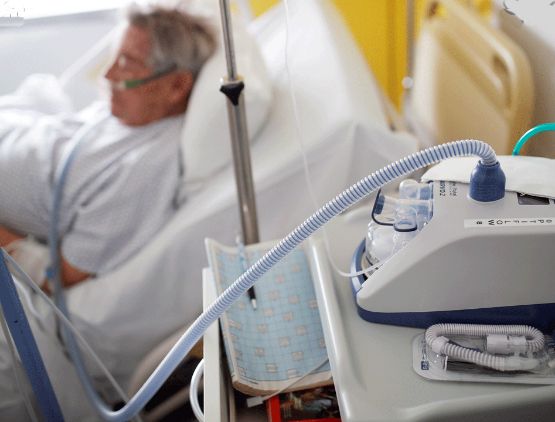
And once an elderly resident of a care home has contracted COVID-19, their only options are to be relocated to intensive care in hospital (likely to be put on a mechanical ventilator which may or may not save them) or stay in place to — as we’ve seen — probably die.
There has been no overall effort to physically distance the residents of long-term care homes into multiple additional locations, even though BC Health Minister Adrian Dix worked long and hard to have empty beds on standby even at locations other than the 19 primary hospital sites. In other words, seniors in care homes and assisted living have actually not been seen as a priority — they could have been physically distanced weeks ago, but instead are left as sitting ducks.
There are a few instances in Ontario and Quebec where people have taken their elderly parents or grandparents out of the care facilities to care for them at home. Perhaps supports for that should be provided in BC instead of taking chances with further outbreaks.
While there are publicly-operated long-term care facilities, in large part the industry has been driven by the profit motive of private-sector corporations for whom seniors-in-care are their inventory.
It’s too soon to know if there will be lawsuits against care homes in BC, but it wouldn’t be surprising to see that happen. After the grief of impacted families lifts and they can organize their concerns against the neglect that brought on this wave of death in care homes, a legal push-back is probably likely and justified.
And why the single-minded distancing rules that have prevented at least one family member from being at the bedside of a dying elder? Using the coveted personal protective equipment (PPE) for visiting persons in that case would be a lot a cheaper (in the end) than the lawsuits and the long-term cost of mental health aspects upon grieving families.
There is still time to change course with how the long-term care home scenarios are being handled.
Low numbers in hospital and a flattened curve:
BC’s evident success with ‘flattening the curve’ looks good on BC and its public health machine (see April 17 modeling on the BC CDC website). But it is openly known that many people in the general population have had (or do have) mild symptoms that do not require access to formal health care. Many others are thought to have been (or presently are) entirely asymptomatic. Even asymptomatic persons can shed the virus, we are now told by public health officials.
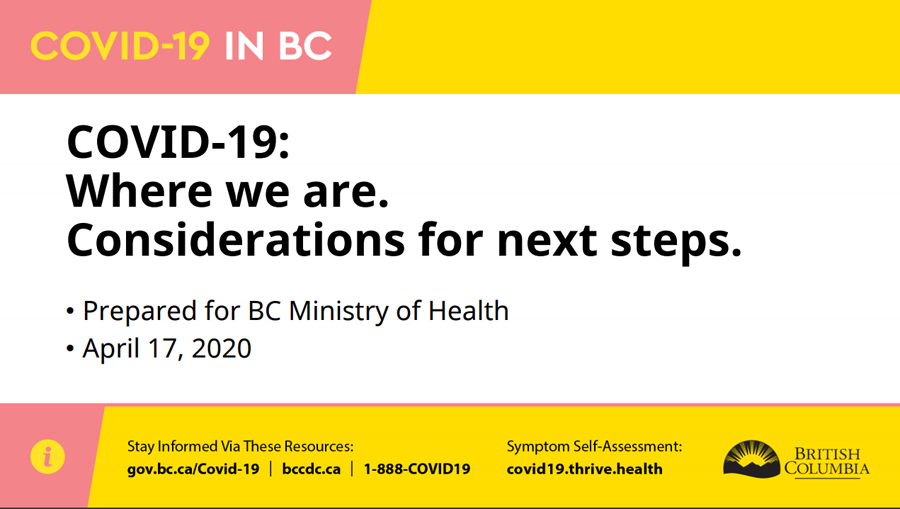
Making the infection rate look good (i.e. low test case count and managed hospital intake), BC will be relying on serology (blood) testing to detect the presence of antibodies, said Dr Henry today. Later on, this will show how many people were infected but most won’t have been included in test-positive or hospitalization stats.
The only way to have community immunity (aka ‘herd immunity’) is to have an effective vaccine. That will take time — thought by public health and scientists to be about 18 to 24 months away after a vaccine (if found/developed) is then properly tested, manufactured, and distributed where and as needed.
How BC flattened the curve:
The economy has been put into a coma. Sectors one by one were shut down over a matter of days and weeks, leaving only some (deemed essential) to operate for food supply, financial services, vehicle gasoline and repair, provide accommodation (such as hotels), and of course health care.
Shut out of the workplace, British Columbians have been self-isolating at home since mid-March (with some early-adopters doing that on their own initiative starting in late February or early March). This retreat to the home space was in response to a series of orders from the Public Health Officer, effectively creating a society-wide lockdown.
In-class learning in BC was officially suspended on March 17 which put all families into instant learn-at-home mode (after the end of spring break at March 30), which dramatically decreased the possibility of spread between families; after spring break the rollout of remote learning has been underway. Children of essential workers have been attending classes in BC schools (including three elementary schools in the west shore), where physical distancing and cleaning standards have been adhered to.
How COVID-19 is changing everything:
The economic impact has sent everyone reeling — individuals, families, businesses, social networks, community activities, and entire industry sectors (such as airline travel and tourism). Governments have turned their pockets inside out to pour money into homes, businesses and key sectors of the economy. Changes to support programs occur pretty much daily — like trying to plug every new hole in a leaky boat.
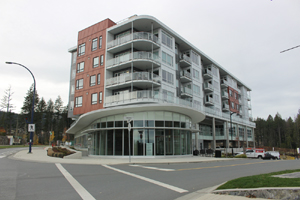
While it all looks pretty good right now, people and businesses are understandably itching to get back to some sort of normal, and government coffers are not bottomless pits.
Politicians who have quickly learned the public health lingo are reinforcing that the ‘new normal’ is a mix of dealing with the active virus while gently reactivating the economy. The ‘normal’ that we knew pre-COVID is essentially gone forever.
Once there is finally a vaccine delivered to enough of the population — expected in about 18 to 24 months — our expectations, habits, behaviours and processes as a society will have been dramatically changed. Many people will have lost jobs, lost businesses, and suffered losses in their families and relationships. People will have become accustomed to private space and will be understandably cautious about rejoining an group-active social framework of activities in workplace, community or travel. In short, the COVID-19 is spooking us all, at every level. Nothing and no one will be same after this.
Positive outcomes from COVID-19:
Many good things will come of COVID-19. We’re already seeing the many gaping holes in the economy for workers and small business, youth and seniors, and some pitfalls in education/social services model but already finding ways to adapt and repair.
We’ve seen the horrific scenario of death unfolding in long-term care homes, and that will most certainly be addressed once COVID-19 is over, though it is still a mystery while seniors in care homes aren’t now being dispersed more broadly based on the principles of physical distancing. That the military has had to send in medically-trained personnel from among their ranks, to help in care homes (in Quebec and Ontario) should underscore how badly the long-term care system has failed families. The blame is not all on government however; as a society we have turned a blind eye to the parking-aside of seniors as if they had already expired instead of appreciating and valuing their wisdom and experience.

We’re now all practicing the sort of good hand hygiene that we should have always been doing, but now it will very likely stick including the insistence of hand washing/sanitization in workplaces, schools and community events.
The education system — despite updates in curriculum content and modality — has nevertheless been operating on an old model of packing children into classrooms so parents could head off to work. Some burgeoning school districts in some ways became real estate developers, keenly focused on buying land and constructing more buildings. Now that remote-learning has been forced upon the system by COVID-19, school districts may not need as many buildings; resources can be reapplied into teaching and resources for learning. Unless of course the government figures it can afford to have even more classroom spaces to allow for future physical distancing, in which case more school buildings will be the flourishing capital plan.

While a few of us have worked from home for years, now more career-employees will have been bitten by the ‘remote workplace bug’ and the idea of heading to the office will be altered in significant ways. Remote meetings by way of Internet technologies are already catching on as something that is here to stay.
Long-distance travel will change. While some seasoned travellers will be eager to fly afar once again — that escape methodology will probably also lose some of its appeal for many reasons, not the least of which are putting less fuel emissions into the environment and realizing that home is not so bad afterall (are those far away fields truly greener)? Maybe we can learn to respect each other’s space without having to fly thousands of miles away to fantasy land.

The environment is a huge winner. With significantly less fuel emissions from airplanes, cars and trucks, the air is fresh. Have you seen how clear the skies are at night in the city now (something our rural cousins enjoy more often) — you can see the nearby planets and the stars! When you go for a walk, what you breathe seems freshly new. You can hear birds singing early in the morning and all day long, as the roar of buses, trucks and cars has been significantly minimized.
A victory for science and public health has been achieved. Without those disciplines we would be seeing a much worse scenario of illness and death during the COVID-19 pandemic. As well, societal concepts in support of mental health and well-being are getting room to grow and being applied effectively; that we’re keenly aware about the impact of self-isolation on mental health at this point will help us have systems in place as we move out of this intense first phase of the pandemic.
===== About the writer:
Mary Brooke, B.Sc. has a degree in nutrition health science with a strong component in community education, as well as studies in sociology. She has been covering the daily BC Health and PHO COVID-19 news conferences, and many aspects of COVID-19 developments in BC.
===== Articles about COVID-19:
Use the search tool in this website for “COVID-19” to see all articles on this topic.



